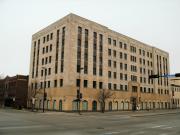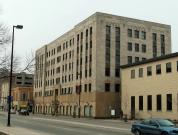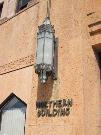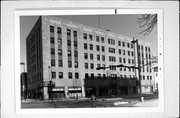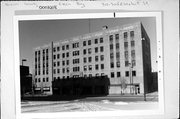Property Record
305 E WALNUT ST
Architecture and History Inventory
| Historic Name: | Northern Building |
|---|---|
| Other Name: | Northern Building |
| Contributing: | Yes |
| Reference Number: | 2218 |
| Location (Address): | 305 E WALNUT ST |
|---|---|
| County: | Brown |
| City: | Green Bay |
| Township/Village: | |
| Unincorporated Community: | |
| Town: | |
| Range: | |
| Direction: | |
| Section: | |
| Quarter Section: | |
| Quarter/Quarter Section: |
| Year Built: | 1930 |
|---|---|
| Additions: | 1995 |
| Survey Date: | 19862017 |
| Historic Use: | large office building |
| Architectural Style: | Art Deco |
| Structural System: | Reinforced Concrete |
| Wall Material: | Limestone |
| Architect: | SOMERVILLE ASSOCIATES; Foeller, Schober, and Berners ; Selmer Company (builder) |
| Other Buildings On Site: | |
| Demolished?: | No |
| Demolished Date: |
| National/State Register Listing Name: | Green Bay Downtown Historic District |
|---|---|
| National Register Listing Date: | 5/13/2019 |
| State Register Listing Date: | 2/16/2018 |
| National Register Multiple Property Name: |
| Additional Information: | Excellent restrained example of the style. The building rests on a polished granite plinth foundation with the taller first floor being sided in buff colored limestone. The principal facade faces east, is symmetrical and has two very shallow slightly projecting four-bay-wide pavillions flanking the nine-bay-wide central portion. The second floor windows on the two pavillions have mitered arch buff colored limestone surrounds. The windows on the third through sixth floors of the pavillions are separated into four bays by plain limestone clad pilasters with the spandrels between each floor in the pavillions bare cast stone panels with cartouches in their centers. The second floor windows in the central portion have flat-arched buff limestone surrounds while the third through sixth floors have simple inset panels as spandrels between them. A wide inset cast stone freize band encircles the building below the parapet and is divided into separate panels over each of two window groups. The band has a repeated highly stylized floriated pattern of blooming flowers done in colored cast stone. The original display windows on the first floor have been altered, but the openings are original and retain their original cut stone surrounds. A decorative incised cut stone stringcourse bearing a repeated chevron and scallop pattern encircles the building just above the display windows. The fine cut stone two-story tall entrance surround is intact and has two large bronze lamps flanking the doors. The entrance doors are modern but open into the intact marble walled entrance vestibule with its Art Deco style chevron and dart plaster coved molds at the wall and ceiling juncture. The original wooden inner doors lead to the intact elevator lobby with its original decorated elevator doors. All windows have been replaced above the first floor with modern 1/1 lite energy efficient units. The Northern Building is one of the few examples of larger office buildings in Green Bay still extant and is the most elaborate in terms of quality of materials and design detailing. Green Bay has a large number of Art Deco commercial and institutional buildings, but most have been altered especially in respect to the loss of original windows and alterations to the public interior spaces. The Northern Building not only retains its exterior, but is unique in retaining its well decorated entrance vestibule and elevator lobby, as well. Built by the Northern Finance Company; designed by Selmer Company (contractor). GEOMETRIC ART DECO ORNAMENT ABOVE WINDOW BANKS. THREE PART SYMMETRICAL FACADE WITH CENTRAL ENTRY. A 'site file' exists for this property. It contains additional information such as correspondence, newspaper clippings, or historical information. It is a public record and may be viewed in person at the State Historical Society, Division of Historic Preservation. 2017-NRHP District Nomination Constructed for the Northern Finance Company, this building was designed by the Foeller, Schober, and Berners firm and constructed by the Selmer Company. At six stories in height, this is one of Green Bay’s few historic examples of a large office building, and its Art Deco style is one of the city’s most elaborate with regard to details and material quality. The building underwent renovations in 1994 to become government offices for Brown County, but a high degree of exterior design [historic material] has been maintained. The Northern Building sits at the northeast corner of E. Walnut and N. Adams streets. The wide, symmetric, primary façade faces E. Walnut to the south. Here, a two-story central entrance surround for the door and second-story windows with original bronze lamps remains intact. The first-floor fenestration of this six-story building has been altered. Eight wide storefront windows have been replaced with sixteen narrower rectangular windows, each with a triangular panel above and recessed in a pentagonal opening. An original, decorative, incised, cut stone stringcourse with chevron and scallop pattern extends around the two street-facing façades of the building above the first-floor windows, marking the transition of alterations below and original building design above. A wide, plain, stone frieze above this stringcourse extends to the sills of the second story windows. The primary façade is divided into nine bays. The center bay has three window openings per floor above the entrance doors. Other bays each have two windows per floor. The central portion of the façade is five bays wide. The two bays at either end of the façade project slightly. Panels between the tops and bottoms of the windows are given different treatments; those in the two bays to the left and right of the center bay have simple panel insets at the third and fourth floor, while those in the four outermost bays have cast stone panels with central cartouche at the third, fourth, and fifth floors. Second story windows of the outermost bays have applied pentagonal stone surrounds with carved details above the window. Second story windows in the four bays adjacent to the entrance have incised details carved in the wall between each window, along with decorative stone panels centered vertically between the first and second story windows. A wide inset cast stone frieze band extends around the two street-facing façades below the parapet. This band is divided into separate rectangular panels over each bay and circular panels between; they feature a stylized, Art Deco floriate pattern. The west façade, overlooking N. Adams Street, is three bays wide. The center bay has three windows at each floor, while the side bays each have two. The side bays have cast stone panels with central cartouche vertically separating the second, third, fourth, and fifth story windows. Second story windows in the bays have pentagonal surrounds, and panels are centered vertically between the second and third story windows of the central bay. Aside of the frieze band near the parapet, the remainder of this façade is primarily stone block. The east façade matches the west, but lacks first story windows. The north façade is brick. Most of the windows openings on the north façade have been filled with brick, but the bay closest to N. Adams Street retains two windows per floor in the second through sixth floors. Additionally, the building originally had a C-shape plan when built, with a recess in the center of the north façade. That recess has since been filled with matching cream color brick, resulting in a rectangular plan for the building. All upper-story windows have been replaced with modern 1/1 types. |
|---|---|
| Bibliographic References: | (A) Sanborn-Perris Map Co. Inc. Fire Insurance Map of Green Bay, Wisconsin. New York, 1957. (B) Green Bay Press-Gazette, Tercentennial Edition, 1934, Civic and Social Section, p. 42. (C) Wisconsin Magazine, Green Bay Edition, 1959, p. 95. (D) GREEN BAY PRESS-GAZETTE 1/9/1995. (E) Timothy Heggland et al., Green Bay Intensive Survey Final Report (Green Bay: Redevelopment Authority, 1988), 259. |
| Wisconsin Architecture and History Inventory, State Historic Preservation Office, Wisconsin Historical Society, Madison, Wisconsin |

